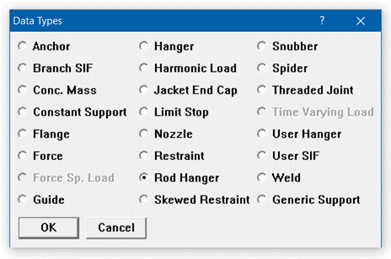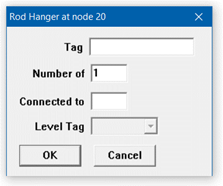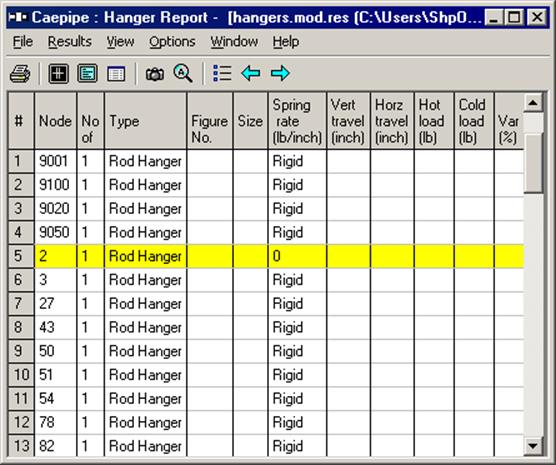Rod Hanger
A rod hanger is a rigid one-way vertical support. The rod hanger node is rigidly supported against downward movement but able to move freely in the upward direction. That is, the rod hanger is rigid in tension (downward movement) and has no stiffness in compression (upward movement). CAEPIPE considers a rod hanger to always act in the vertical direction.
A rod hanger is input by typing “ro” in the Data column or selecting “Rod Hanger” from the Data Types dialog.

By default, one rod hanger without a connected node is input. The number of hangers and the node to which it may be connected to may be specified in the Rod Hanger dialog.

Number of Hangers
The number of hangers is the number of separate rod hangers connected in parallel at this node.
Connected to Node
By default the rod hanger is connected to a fixed ground point which is not a part of the piping system. A rod hanger can be connected to another node in the piping system by entering the other node number in the “Connected to” node field. This node must be directly above the rod hanger node.
A rod hanger in CAEPIPE functions as a vertical limit stop, that is, it functions as a nonlinear one-way restraint. It is rigid in -Y direction and fully flexible in +Y direction (in a Y-vertical system). The rod hanger offers no resistance in +Y direction.
Rod hanger results are included in the hanger report, which reports results for the first operating case (W+P1+T1). In the hanger report, a rod hanger’s spring rate may be shown either as Rigid or zero, the latter potentially confusing to the user.
It simply means that there is possibly liftoff at the rod hanger location for the first operating case. You can confirm this by studying vertical displacement (Y or Z) at the rod hanger for the first operating case (which will be 0 or positive). If this vertical displacement is zero, it means the rod hanger is in tension and its sprig rate is shown as Rigid; on the other hand, if this vertical displacement is positive, then the rod hanger is in compression and its spring rate is shown as zero. You can find reports for other operating load cases under Support Loads > Other Supports > Rod Hangers.
Liftoff (i.e., zero spring rate and a positive operating condition displacement) indicates that the rod hanger may not be needed and hence could be removed. You will need to study the effect on the system at other supports after removing the rod hanger.
In dynamic analysis, the status of the rod hanger from the first operating case (W+P1+T1) is used, i.e., if the rod hanger is in tension in the first operating case, a rigid vertical two-way restraint is used in dynamic analysis. If the rod hanger is in compression in the first operating case (possible liftoff), no vertical restraint is used at that location in dynamic analysis.
